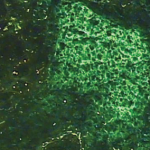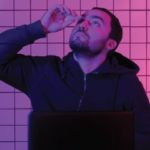As a medical student, I was not prone to diagnosing myself with the “disease du jour.” A distance swimmer and triathlete, I imagined myself to be one of the least likely people to develop a chronic disease in the prime of my life. But it happened.
In retrospect, there were warning signs. My eyes had been dry and irritated since adolescence. An unusual fatigue had been building for years. At age 44, following a minor surgical procedure on an injured disc, my health disintegrated suddenly and rapidly. I developed overwhelming fatigue, constant migraines, abdominal pain, nausea, and diarrhea. It felt as though every cell in my body was soaking in a toxic marinade. At first, this seemed to be caused by a medication reaction. Yet the puzzling array of symptoms worsened as the months went by.
None of my doctors suspected Sjögren’s syndrome, despite a suggestive history, including punctual cautery for severe dry eyes, chronic sinusitis, muscle pain, and stubborn tendonitis affecting multiple joints. After an unremarkable gastrointestinal workup, I was told that I probably had a severe form of irritable bowel syndrome. It was obvious to me that something much more serious was going on and it was not just affecting my gut.
One year into this ordeal, I had done enough research to suspect Sjögren’s as the probable culprit. Despite testing negative for Sjögren’s antibodies, I insisted on a rheumatology referral and a minor salivary gland biopsy. The biopsy was abnormal, yet it was discounted because of a low focus score. Despite an unclear diagnosis, I started prednisone. In just a matter of days, my gastrointestinal symptoms remarkably improved. So much for irritable bowel!
I have had the good fortune to work with an excellent rheumatologist who was willing to treat me in those early years as “probable Sjögren’s,” based on the clinical picture. Seven years into the illness, a second salivary gland biopsy confirmed my diagnosis.
The Problem with Diagnosis
Most people in my situation would have been told that they did not have Sjögren’s. I know women with similar stories who were told their symptoms were due to stress or menopause (90% of patients with Sjögren’s are women). Because depression, thyroid disease, celiac, and fibromyalgia are common comorbidities in patients with Sjögren’s, they can distract providers from looking for an underlying cause that connects the scattered symptoms.
My delayed diagnosis is typical. According to a recent study by the Sjögren’s Syndrome Foundation, the average time to diagnosis is 4.7 years. Because symptoms are heterogeneous, the diagnosis often takes time and thoughtful coordination of care. This approach does not fit in well with our current medical system of fragmented care and 15-minute appointments. If Sjögren’s is diagnosed, there are no standardized clinical practice guidelines, which places clinicians in the frustrating position of lacking good evidence-based tools for management.
None of this would be surprising if Sjögren’s was a rare disease. However, it vies with rheumatoid arthritis (RA) for the dubious distinction of being the most common autoimmune disease. According to the most recent (2008) National Arthritis Data Workgroup, primary Sjögren’s affects up to 3.1 million U.S. adults.1 If secondary Sjögren’s is included, a fairly conservative estimate would be 4 million affected, approximately 1% of the adult population. Yet most of these patients remain undiagnosed. We are simply living under the radar.
There is an emphasis on treating many other autoimmune diseases, such as RA, early and aggressively. In RA, this approach has been shown to improve clinical outcomes. Efforts to identify RA in the “prearthritis” stage have been recently promoted, in the hopes of preventing actual clinical disease. The contrast to the prolonged delays in diagnosing Sjögren’s patients with full-blown disease could not be more stark. There is little incentive to diagnose the disease in a timely manner when it has not been proven that treatment will improve outcomes. It simply has not been studied.
Self-Perpetuating Bias
Perhaps the greatest stumbling block to making the diagnosis of Sjögren’s is the self-perpetuating bias of the medical community that we are just not that sick. This was what I was taught in medical school. This notion seems to ignore the 20–40% of patients with severe systemic manifestations.2 Pain, fatigue, gut dysmotility, and neuropathies are not considered to be severe manifestations. Yet, these extremely common features are frequently far more debilitating than dryness. Many rheumatologists focus on dryness, often ignoring the extraglandular symptoms, particularly fatigue. Almost every Sjögren’s patient I know has heard some version of, “Just be glad you don’t have lupus.” This is about as sensitive as telling a breast cancer patient to be glad that she doesn’t have ovarian cancer. We have an illness that can turn our lives upside down.
More Than Dry
Sicca symptoms are important. I know this firsthand, having severe dry eye disease, including a painful neuropathic component. However, what impacts my life the most is the disabling flu-like fatigue that is seen in 70% of primary Sjögren’s patients.3 This is not normal exhaustion that can be managed with rest and recovery. Because of fatigue, I have had nothing resembling a normal life for the past 11 years. I simply hit the wall by early afternoon every day, even on my best days. During my flares, I am only out of bed (in a total daze) for six to eight hours a day. This bed rest is nonnegotiable. If I push myself too much, the disease spirals out of control, leaving me incapable of performing even simple tasks like running an errand. No amount of willpower or strategizing has allowed me to change this. It has severely affected my family life: as my children were growing up, I stayed at home as they went on vacations with their father, visiting Europe, Canada, and many wilderness areas closer to home. This relentless fatigue does not suit my personality at all. I want to practice medicine. I want to travel, ride my bike, cook great meals, and have an occasional evening out. These are simply not compatible with my current energy budget.
New Criteria Too Restrictive
The diagnosis of Sjögren’s remains controversial and problematic. There is no simple test that is sensitive, specific, and noninvasive. Finding a novel biomarker that can identify Sjögren’s early and accurately will be of enormous benefit. In 2012, the ACR published new and stringent criteria for the classification of Sjögren’s.4 While narrowed criteria may be useful for research, these criteria are unnecessarily restrictive for use in the clinical setting.
Delaying the diagnosis, and thus the treatment, prolongs suffering and could impact the progression of disease. Until we have better tests available, there needs to be a clear message that many patients with Sjögren’s will not meet these stringent criteria, and should be managed based on the clinical picture. Clinical diagnosis is hardly a new concept to rheumatology. RA is often diagnosed based on clinical evaluation in the early stages. Research criteria do not need to be the same as clinical criteria. Rheumatologists use 4/11 criteria for lupus study populations, yet, for some, 3/11 criteria are considered sufficient to initiate treatment.
Medical Management and Clinical Studies
While some progress has been made in the treatment of dry eyes and dry mouth, few studies have looked at the impact that treatments have on systemic manifestations. The lack of clinical studies for Sjögren’s is astounding, given its high prevalence. Without such basic information, how can we possibly know if early intervention will make a difference?
Clinical studies for Sjögren’s tend to be small, short term, and poorly controlled. According to a recent review by Ramos-Casals et al,5 only five studies have examined the use of hydroxychloroquine, a mainstay of treatment. Only one of these was a randomized controlled trial. Two other commonly used medications, prednisone and methotrexate, have not been specifically studied for their impact on extraglandular manifestations. While new biologic agents keep appearing on the market, they are almost exclusively studied in other diseases. Because my disease has been severe, I have gone out on a limb and tried a number of these medications—without much success—despite a lack of evidence for their use. I’m brave enough, and desperate enough, to take big risks. But having no data to support these “n of 1 experiments” is rather unsettling.
A Wish List for Research and Clinical Management
Research
- Make it a priority to find a definitive test, such as a novel biomarker, that can accurately identify Sjögren’s or even preclinical disease.
- Clearly define the spectrum of manifestations of Sjögren’s. Study large numbers of patients to determine:
- The prevalence of various symptoms and complications, including fatigue, pain, quality of life, and cognitive function, which are often overlooked in research and clinical settings.
- The tendency of the disease to flare and progress, with and without treatment.
- Which interventions make a difference. We must start thinking outside the box. Many experts agree that various environmental factors may be key in triggering autoimmunity in a variety of diseases. It seems logical that different triggers may combine to push susceptible individuals over the tipping point into clinical disease.
- How diet, pathogens, the microbiome, stress, pain, and toxins affect the development and progression of Sjögren’s. What is the role of complementary medicine?
Clinical Practice Guidelines
- Create practical guidelines for management, not limited to sicca complex. The Sjögren’s Syndrome Foundation is currently engaged in this initiative.
- Implement a meaningful disease activity index that includes an assessment of fatigue, pain, and quality of life at every visit.
- Routinely assess common systemic manifestations, including gastrointestinal, respiratory, cognitive, and neurologic manifestations.
Educate Medical Providers, Including Those in Primary Care, about Sjögren’s
Most clinicians are either unfamiliar with Sjögren’s or underestimate the prevalence and severity of the disease.
- Sjögren’s needs to become a front-burner diagnosis. Clinicians who treat adult women probably see a significant number of Sjögren’s patients, frequently missing clues that could lead to diagnosis.
- Train clinicians about the common and scattered manifestations of the disease. Recommend steps to diagnosis and basic management of common symptoms.
- Clinicians should understand that the current classification criteria are meant to be used for research, and can be misleading when applied to individual patients in a clinical setting for the purposes of diagnosis. Lack of laboratory or biopsy confirmation does not rule out diagnosis.
- And finally, stop telling us to be glad that we don’t have lupus!
Dr. Schafer is a patient with Sjögren’s and an advocate for the Sjögren’s Syndrome Foundation. Previously, she was a public health physician focused on child health, family planning, and STD for the city of San Francisco and Contra Costa County.
References
- Helmick CG, Felson DT, Lawrence RC, et al. National Arthritis Data Workgroup. Estimates of prevalence of arthritis and other rheumatic conditions in the United States, Part I. Arthritis Rheum. 2008;58:15-25.
- Seror, R, Ravaud P, Bowman S, et al. EULAR Sjögren’s Syndrome disease activity index: Development of a consensus systemic disease activity index for primary Sjögren’s syndrome. Ann Rheum Dis. 2010;69:1103-1109.
- Ng, Wan-Fai. Primary Sjögren’s syndrome: Too dry and too tired. Rheumatology. 2010;49:844-853.
- Shiboski SC, Shiboski CS, Criswell A, et al. American College of Rheumatology classification criteria for Sjögren’s syndrome: A data-driven, expert consensus approach in the Sjögren’s International Collaborative Clinical Alliance Cohort. Arthritis Care Res (Hoboken). 2012;64:475-487.
- Ramos-Casals M, Brito-Zeron, P, Siso-Almirall A, Bosch X, Tzioufas AG. Topical and systemic medications for the treatment of primary Sjögren’s syndrome. Nat Rev Rheumatol. 2012;8:399-411.



